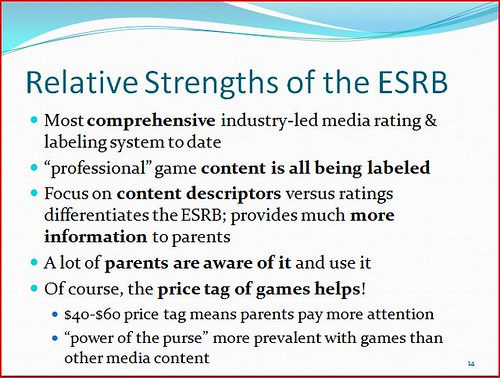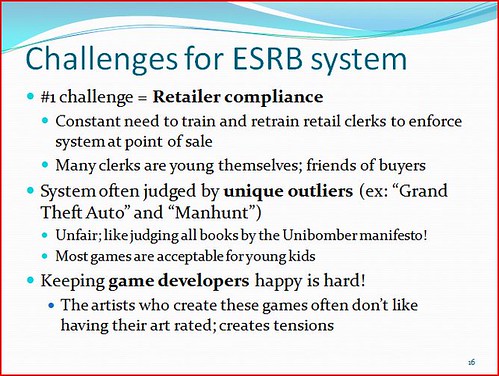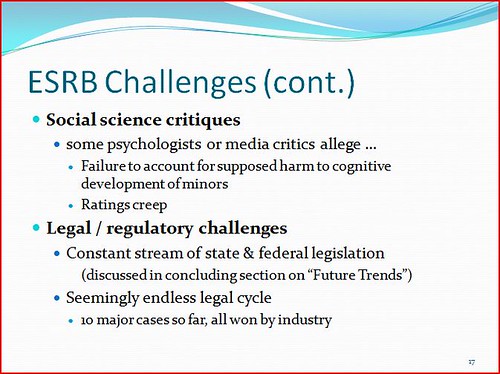Today and tomorrow I am attending a terrific conference at Penn State University called, “Playing to Win: The Business and Social Frontiers of Videogames.” It features panel discussions about various legal and business issues facing the video game industry, as well as discussions about how video games are used to aid teaching and learning. There are also panels on multiplayer online worlds and virtual reality environments and the issues surrounding both. [They will apparently be posting videos from the conference on their site shortly.]

The folks at PSU were kind enough to invite me to deliver the luncheon keynote on Day 1 and I decided to provide a broad overview of the policy issues facing video games that I have covered in some of my past work. My presentation was entitled, “Video Games, Ratings, Parental Controls, & Public Policy: Where Do We Stand?” and the entire 36-slide presentation is now available online here. Down below, I thought I would just outline a couple of the key themes I touched upon in my presentation.
ESRB: Strengths & Challenges
One of the things I did in my presentation was to provide a brief sketch of how the Entertainment Software Rating Board (ESRB), the game industry’s voluntary rating and labeling system, works. After doing so–again, you can download the entire presentation if you want those details–I outlined the strengths of the ESRB system, which I listed as follows:
Then I discussed some of the challenges facing the ESRB system…
General Thoughts on Ratings vs. Government Regulation
Later in the presentation, after walking through how various parental control tools worked, I talked about my general feelings regarding critiques of private rating systems and the ESRB in particular:
Future Issues & Controversies
I concluded by throwing out a few predictions about future issues and controversies that I think we will be debating in coming months and years.
I suppose I should provide some more details regarding this last slide since it will be of the most interest to many readers. Here’s some more explanation regarding each of my 7 predictions:
(1) Renewed push for universal media ratings: This issue has always been hanging out there and I think we will continue to hear calls–from both policy makers and media critics–for some sort of universal rating system for all media. God only knows how that would work. The last Star Wars movie (“Revenge of the Sith”) yielded several distinct media products: a major theatrical motion picture, a video game, a book, a comic book, and even a musical soundtrack. Should they all be rated the same way using the same system? I think that would be difficult to pull off. More worrisome is the fact that any move toward a universal rating scheme would undermine much of the education and awareness-building efforts that have helped familiarize consumers (especially parents) with the ESRB and other existing private rating and labeling systems. Finally, because it is unlikely we will ever see a voluntary movement by all major media producers to abandon their existing rating schemes and adopt a universal system, such a move would likely only come about because of action by government officials. Of course, that raises a host of First Amendment issues. For that reason, we might instead see a push for…
(2) Oversight of ESRB by Congress or non-profit / academic groups: Some critics say that the ESRB needs more “objective” oversight by either a regulatory agency or some of the third-party group, like an academic institution. As I point out in some of those slides above, ratings will ALWAYS have a subjective element to them since raters all bring different values and insights to the task of judging artistic expression. So making the rating process more bureaucratic isn’t going to make matters any better. Instead, it will just politicize the system and slow it down. [See my lengthy essay on this issue from a few weeks ago.]
(3) More FTC oversight of retailer enforcement: The Federal Trade Commission already conducts secret shopper surveys and issues an occasional report about the “Marketing of Violent Entertainment to Children.” Those reports has shown that retailer enforcement of the ESRB rating system is improving, but still needs to improve. [Here you will find my detailed thoughts on the conclusion of the last FTC report.] But there have been some calls in Congress for stepped-up FTC oversight, and potential penalties, for retailers who fail to enforce the system properly. (Remember Sen. Clinton’s “Family Entertainment Protection Act”?)
(4) Mandatory age verification for MMOGs & online activities: Here’s one to keep a close eye on. With a debate raging about the wisdom and effectiveness of age verification for social networking sites, it’s only a matter of time before online video games are brought into the discussion in a major way. The recent Bryon report in the UK included a discussion of this in the online gaming section of their final report. Stay tuned, this debate is set to explode here in the States.
(5) Mandatory parental controls defaults: One of my next white papers discusses the perils of government mandates that might force media & technology providers to not only embed parental controls in all their devices, but also turn them “ON” when they are shipped to market (meaning they would set to their most restrictive position as a defaults). For example, it could be required that every video game console be shipped with on-board screening technologies that were set to block any games rated above “E” (i.e., “Everyone”-rated games). Similarly, all personal computers or portable media devices sold to the public could be required to have filters embedded that were set to block all “objectionable” content, however defined. If “default” requirements such as this were mandated by law, parents would be forced to opt out of the restrictions by granting their children selective permission to content above a certain ESRB rating. In theory, this might help create another roadblock to underage access to some objectionable content, but it would also create an enormous consumer backlash and lead to a great deal of regulatory hassles and console hacking. Again, I’ve got an entire paper coming out on this issue from PFF next month that addresses my reservations with such a mandate.
(6) What happens when “AO” games hit consoles? I created some controversy recently when I noted that: “Whether any of us care to admit it, the fact that AO-rated games are currently kept off the major consoles and off the shelves at some major retailers (ex: Wal-Mart and Target) is probably the most important thing holding back a full-on legislative assault on video games.” Some took that to mean that I was advocating rigorous self-censorship of “AO” (Adults Only-rated) games. To the contrary, as I told MTV Multiplayer News, “I am in no way advocating that the industry hold off in terms of allowing complete creative expression.” And I also told MTV Multiplayer that I thought that eventually one of the major consoles–probably Sony–would cave and allow some AO-rated games on their platform. But make no doubt about it, when that happens, all hell is going to break loose. Not only with the typical pro-censorship crowd kick their complaint-generating factories into high gear, but a lot more average parents will protest the move and likely petition lawmakers for greater regulation of games or consoles.
(7) What about virtual reality games? And finally we come to virtual reality. All these other video game debates we have been having pale in comparison to the heated debate we can expect during the coming decade as virtual realities games and devices proliferate. And we all know they are coming. I fully expect that something like the Star Trek “holo-deck” will be in my living room by the time my kids are teenagers. We are already seeing more “tactile” devices coming to market, such as steering wheels and video game guns, that add a new layer of involvement to the games we play. Most recently, video game vests are hitting the market that simulate the sensation of being shot while playing a game. Once you combine these tactile technologies with more visually immersive visual display technologies, we will be well on our way to a serious VR world. And once they figure out a way to make it fully online and interactive, a huge policy debate is going to develop over the wisdom of letting people (especially kids) play holo-deck games where they actually feel like they are inside Halo or World of Warcraft, mowing down competitors with plasma rifles and broad swords. (Personally, I am very eager to try out “Resident Evil” this way!) Regardless, this debate is coming and it will be a very heated affair.







 The Technology Liberation Front is the tech policy blog dedicated to keeping politicians' hands off the 'net and everything else related to technology.
The Technology Liberation Front is the tech policy blog dedicated to keeping politicians' hands off the 'net and everything else related to technology.